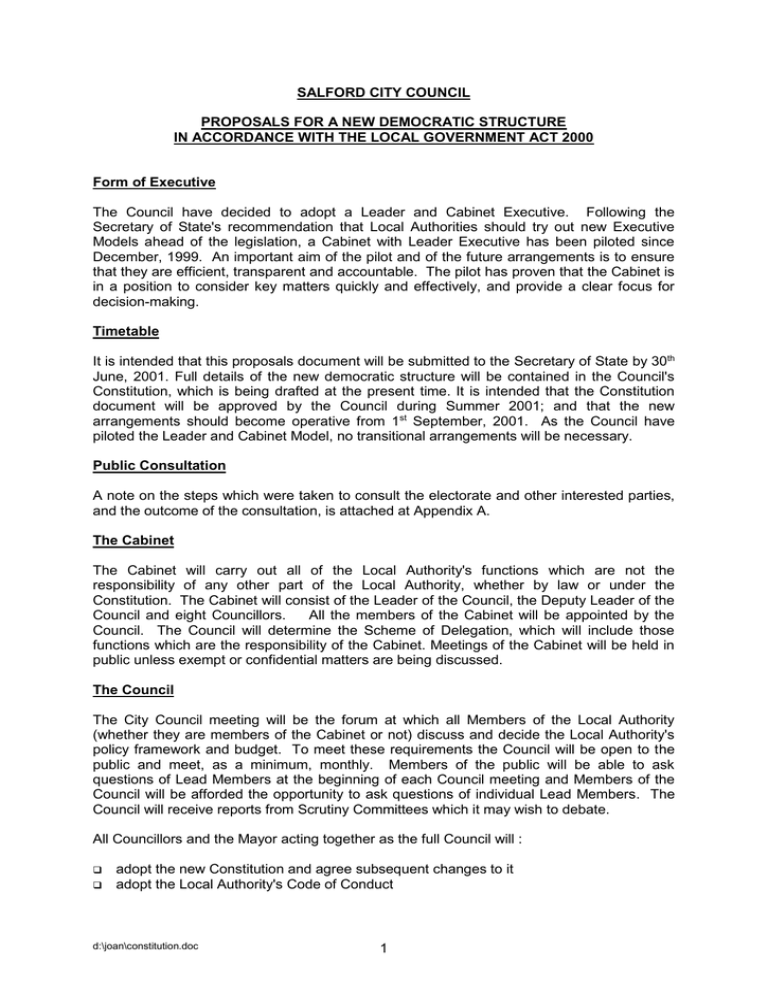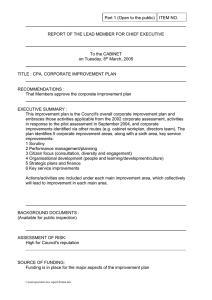SALFORD CITY COUNCIL PROPOSALS FOR A NEW DEMOCRATIC STRUCTURE
advertisement

SALFORD CITY COUNCIL PROPOSALS FOR A NEW DEMOCRATIC STRUCTURE IN ACCORDANCE WITH THE LOCAL GOVERNMENT ACT 2000 Form of Executive The Council have decided to adopt a Leader and Cabinet Executive. Following the Secretary of State's recommendation that Local Authorities should try out new Executive Models ahead of the legislation, a Cabinet with Leader Executive has been piloted since December, 1999. An important aim of the pilot and of the future arrangements is to ensure that they are efficient, transparent and accountable. The pilot has proven that the Cabinet is in a position to consider key matters quickly and effectively, and provide a clear focus for decision-making. Timetable It is intended that this proposals document will be submitted to the Secretary of State by 30th June, 2001. Full details of the new democratic structure will be contained in the Council's Constitution, which is being drafted at the present time. It is intended that the Constitution document will be approved by the Council during Summer 2001; and that the new arrangements should become operative from 1st September, 2001. As the Council have piloted the Leader and Cabinet Model, no transitional arrangements will be necessary. Public Consultation A note on the steps which were taken to consult the electorate and other interested parties, and the outcome of the consultation, is attached at Appendix A. The Cabinet The Cabinet will carry out all of the Local Authority's functions which are not the responsibility of any other part of the Local Authority, whether by law or under the Constitution. The Cabinet will consist of the Leader of the Council, the Deputy Leader of the Council and eight Councillors. All the members of the Cabinet will be appointed by the Council. The Council will determine the Scheme of Delegation, which will include those functions which are the responsibility of the Cabinet. Meetings of the Cabinet will be held in public unless exempt or confidential matters are being discussed. The Council The City Council meeting will be the forum at which all Members of the Local Authority (whether they are members of the Cabinet or not) discuss and decide the Local Authority's policy framework and budget. To meet these requirements the Council will be open to the public and meet, as a minimum, monthly. Members of the public will be able to ask questions of Lead Members at the beginning of each Council meeting and Members of the Council will be afforded the opportunity to ask questions of individual Lead Members. The Council will receive reports from Scrutiny Committees which it may wish to debate. All Councillors and the Mayor acting together as the full Council will : adopt the new Constitution and agree subsequent changes to it adopt the Local Authority's Code of Conduct d:\joan\constitution.doc 1 agree the Local Authority's Policy Framework and Revenue and Capital Budgets, including the Annual Library Plan Best Value Performance Plan Children's Services Plan Community Care Plan Community Strategy Crime and Disorder Reduction Strategy Early Years and Child Care Development Plan Education Development Plan Local Transport Plan Plans and Strategies which together comprise the Development Plan Youth Justice Plan Council's Corporate Plan Food Law Enforcement Service Plan The Plan and Strategies which comprise the Housing Investment Programme The Adult and Community Learning Plan Local Agenda 21 Strategy Quality Protects Management Action Plan Lifelong Learning Development Plan Capital Strategy Equal Opportunities Strategy Community Legal Services Partnership Strategy E-Salford Housing Revenue Account DLO/DSO Budgets Other Plans and Strategies submitted by the Cabinet Making appointments to Committees Making appointments to the Cabinet Confirming the appointment of the Chief Executive/Directors/second tier Officers Overview and Scrutiny The Council's arrangements for Overview and Scrutiny acknowledge that the integrity of the Cabinet Model of modern Local Government depends on our ability to hold the Executive to account. The proposed arrangements will achieve this by providing for a clear separation of executive and scrutiny functions. The Council will appoint the following committees : Economic and Community Safety Scrutiny Committee Lifelong Learning and Leisure Scrutiny Committee Environmental Scrutiny Committee Quality and Performance Scrutiny Committee Health and Social Issues Scrutiny Committee. Within their Terms of Reference, Scrutiny Committees will : Review and/or scrutinise decisions made or actions taken in connection with the discharge of any of the Authority's functions Make requests and/or recommendations to the full Council and/or the Executive and/or any joint committee or community committee in connection with the discharge of any functions Consider any matter affecting the area or its inhabitants d:\joan\constitution.doc 2 Exercise the right to call in, for reconsideration, Cabinet and Lead Member decisions made but not yet implemented The remit of each of our Scrutiny Committees aims to address the Council's statutory duty to provide for the Social, Environmental and Economic well-being of our community, as well as the Council's fitness for purpose. Membership of Scrutiny Committees will be based on cross-party representation, but each political group has agreed that party discipline will not apply. For specific reviews we will seek expert advice externally and for all reviews, we will actively encourage/seek engagement with the public. The Social Scrutiny Committee will include certain non-elected voting members and all Scrutiny Committees will have the ability to co-opt non-voting members as and when appropriate. Scrutiny Committees will meet in public. Best Value The Council have a comprehensive programme of Best Value Reviews which will achieve 100% coverage of its services over a five year period. The programme of reviews strikes a balance between service-specific and "cross-cutting" themed reviews and will be managed by the Scrutiny Committees, which will utilise a series of member panels to undertake a comprehensive approach to each review. The Council will also enlist the support of external expert advisers in the reviews as required. The outcome of each review will be to produce an Improvement Plan which will be implemented by corporate officer working groups and monitored by the Scrutiny Committees. Probity and High Ethical Standards Members of Salford City Council have adopted a draft Code of Conduct. This embodies ten general principles and then applies them in more detail to the situations which members experience in representing the City Council, their wards and individual members of the electorate. Members recognise that at all times they must conduct themselves in a manner which could not be reasonably regarded as bringing their office or the Authority into disrepute. Also, they must deal with all members of the community equally and fairly and not discriminate against any person, and they understand that their position should not be used improperly in order to confer on or secure for any person an advantage or disadvantage. In order to ensure probity and propriety the Council have appointed a Standards Committee, which includes three independent persons, one of whom is the Chair. It has all-party representation and a member of the Cabinet within its number. The Standards Committee has considered the draft Code of Conduct for Members and has undertaken a series of training events on the Code, which all Members attended. Other Decision-Making Bodies The role and functions of the Council, the Cabinet, Scrutiny Committees, the Standards Committee and Community Committees are described in other sections of these proposals. There are a number of other bodies which will have powers delegated to them under the Scheme of Delegation and these can be summarised as follows: d:\joan\constitution.doc 3 (a) Regulatory Panels There are a number of functions which are not to be the responsibility of an Authority's Executive, and for which two Regulatory Panels will be established in Salford : (i) Planning and Transportation Regulatory Panel This Panel will deal with a variety of functions relating to town planning and development control, including the determination of planning applications and traffic regulation orders. A Co-opted Member of the community will serve on the Panel. In accordance with guidelines, the Lead Member for Development Services will be a member of this Panel. (ii) Licensing and Safety Regulatory Panel This Panel will deal with a variety of functions relating to licensing, registration and health and safety. (b) Area Housing Committees The Council have established 9 Area-based Housing Committees which comprise local Ward Councillors and tenant representatives. The Committees are responsible for monitoring the performance of the Council's Housing Service within their respective areas. (c) Budget Committee This Committee performs a scrutiny function in respect of the Council's budget. (d) Lowry Committee This Committee performs a scrutiny function in respect of the Lowry. Transparency and Accountability These proposals provide transparency and accountability through: Transparency Access for the press and public to meetings. Availability of agenda and reports for meetings and relevant background papers. Publication of decisions. Publications of forward plan of key decisions. Accountability Question Time at Council meetings. Monitoring via Community Committees and Area Housing Committees. Co-option of representatives of the community and local organisations on various bodies. Scrutiny Committees. Standards Committee. Publication of background papers, decisions etc. (see transparency). d:\joan\constitution.doc 4 Involvement of the Community Since late 1993 the Council has operated Local Area Forums known as "Community Committees", set up to recognise the importance of consultation and aiding decision-making at a local level. In July 2000, the City Council recommended a review of their Community Strategy, which is currently being implemented. Community Committees are made up of representatives of community groups within a Service Delivery Area and Ward Councillors. They are supported by officers from all Council Directorates and other agencies. Community Committees have four primary functions (a) (b) developing, implementing and monitoring Local Action Plans which are adopted by the Cabinet and implemented within the decision-making process; managing and monitoring delegated budgets which support the delivery of the Community Action Plan; (c) scrutiny of local services; and (d) the strengthening of partnerships between public and voluntary partners at a local level. Role of Non-Executive Councillors As elected representatives, Councillors have an important leadership and representative role in their communities. Residents turn to Members to help them deal with bureaucracies and sort out problems, regardless of which agency is the cause of the problem. Councillors are often involved in the decision-making process and consultation process on bodies other than the Council, e.g. many are school governors or are involved in area-based partnerships. A key role for non-executive members is in the Community Committee structure. Members can influence the shape of policies and priorities by ensuring strong leadership at the neighbourhood level. Members can play a strong part in the scrutiny of services delivered locally. The commitment and enthusiasm of individual Councillors can, and does, make a difference. GPC/JMC Updated : 10th May, 2001. d:\joan\constitution.doc 5 APPENDIX A LOCAL GOVERNMENT ACT 2000 NEW POLITICAL MANAGEMENT ARRANGEMENTS - PUBLIC CONSULTATION Consultation background This report is intended to set out the consultation arrangements in Salford in connection with the modernisation of local government proposals in the Local Government Act 2000. The work began in the winter of 2000, and was finished in April 2001. The Act requires local authorities to explain how they will respond to the three options set out there for the development of a new constitution. Guidance published by the government has been used in putting together Salford’s consultation on this issue, with the aim that everyone with an interest in doing so has been given an opportunity to take part. The consultation was organised so that every household and business in the city received information, and every community committee also discussed the government’s proposals at a public meeting. What we did The Council proposed pilot arrangements for a new democratic structure in 1999. Leaflets, meetings, a publicity caravan and the local media were used to inform and consult with the community. The Council then piloted the leader and cabinet system from December 1999, so that councillors, staff, partner agencies and the wider local community could assess the suitability of the new structure. For the proposed arrangements in accordance with the Local Government Act 2000, we devised a programme of consultation in line with the DETR’s notes on best practice in consultation. These included the following objectives: the consultation should involve a range of stakeholders the consultation should offer everyone a chance to take part consultation should be both qualitative and quantitative people should be provided with information presented in a clear format We explained how Councils would have to change to one of three alternative ways of working: Option 1 : An elected mayor who takes decisions together with an executive or "cabinet" of up to nine other councillors appointed by the Mayor Option 2 : A leader and cabinet of up to nine other councillors - either elected by the Council or appointed by the leader Option 3 : An elected mayor, with a council manager responsible for the executive functions of the Council. d:\joan\constitution.doc 6 Key target audiences Information was targeted at: Residents Community groups Strategic partners Councillors Staff Managers Businesses Information provided We produced a feature article in the local weekly newspaper, the Salford Advertiser, explaining the three options and giving more information about the choices and the rest of the consultation exercise. The Advertiser’s audited figure for verified free distribution is 91,000. This article included a coupon with a freepost address designed to encourage participation. Further media releases and other opportunities have been used in local radio, TV and other newspapers, to publicise the council’s consultation. As required in the legislation, an advertisement was placed in the Salford Advertiser notifying residents of the number of petitioners needed to trigger a referendum on whether there should be an elected mayor for the City. We also produced a plain language leaflet for use by local people, again explaining the choices using diagrams and giving people the opportunity to respond. This also included a coupon with a freepost address. The leaflet was made available in all public buildings and by post to everyone who expressed an interest, as well as to local organisations. As well as this we featured the detail of the consultation in the council’s magazine Salford People. This publication is delivered by Royal Mail to every letterbox in the city, around 110,000 addresses. Again, we featured a coupon and freepost address to encourage people to take part. Further details will appear in the June 2001 edition. Telephone survey of distribution of the publication indicated that more than 75 per cent of households received the information. The information in Salford People was recorded on audio tape and distributed to more than 500 blind and partially sighted people in the area. The magazine is also made available in large print. Details of the three options, together with an email form, were also posted on the city council’s Website. Officers visited every community committee to explain the detail of the three proposals and urge people to take part in the consultation. Senior councillors from all political parties also attended to offer their views. The magazine and leaflets were made available at these meetings, which were attended by around 450 people in total. Reports on the modernisation agenda have been presented at a series of public meetings involving elected members, including scrutiny committees and the full council meeting. d:\joan\constitution.doc 7 What the results show Responses were received from all coupons: the leaflet, The Advertiser, Salford People, and by email. Most came through Salford People. The vast majority of respondents to the public consultation are in favour of the option of leader and cabinet option; 76% preferred a leader with cabinet; a total of 23% preferred one of the other two options: 11% preferred mayor with cabinet, and 12% preferred mayor with council manager. Around 1% did not know, or did not give an answer. Detailed comments were added to the coupons by some respondents, and these have been taken into account in the consultation. Resources The resources used to carry out the consultation, excluding staff costs, were as follows: Magazine content Newspaper advert Leaflets Audio tape recording d:\joan\constitution.doc £ 2,000 200 1,450 70 3,720 8




